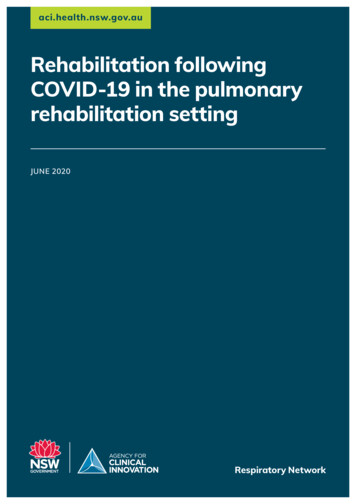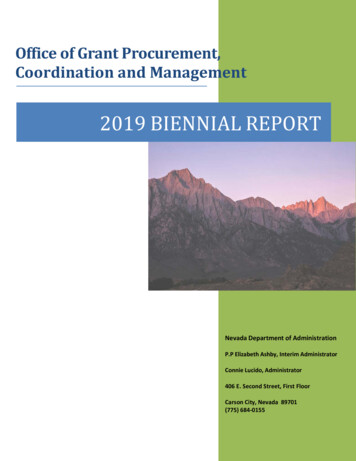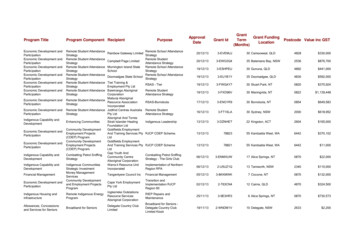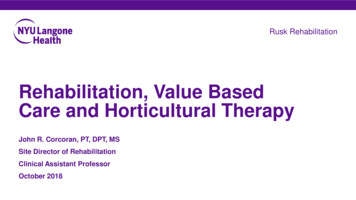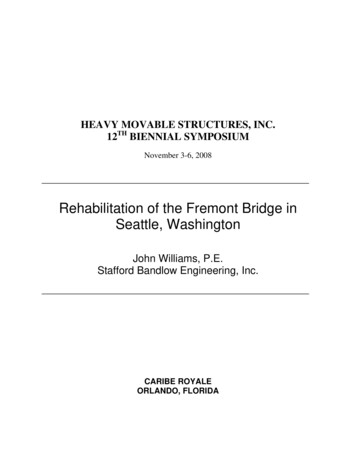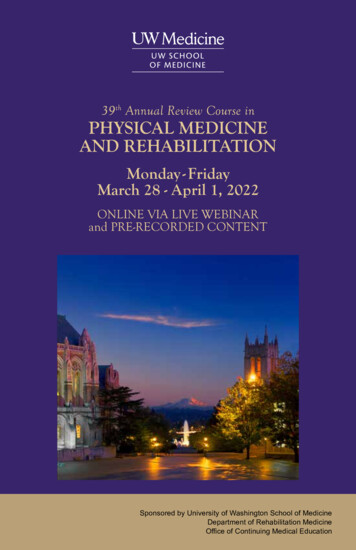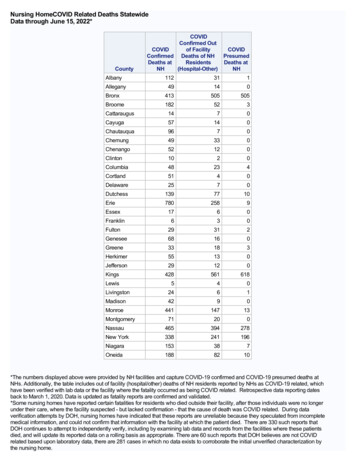
Transcription
HOME REHABILITATION GRANT PROGRAMThank you for your interest in the City of Clovis’ Home Rehabilitation Grant Program. The Home RehabilitationGrant Program can provide financial assistance to correct health or safety issues in low- to moderate-income,owner-occupied households in Clovis (including mobile homes). The assistance is provided as a grant, with amaximum assistance level of 6,000.ELIGIBILITY REQUIREMENTS1. Total gross annual household income cannot exceed the following amounts (adjusted for householdsize):1 Person2 Persons3 Persons4 Persons5 Persons6 Persons7 Persons 39,050 44,600 50,200 55,750 60,250 64,700 73,6002. Cannot have received home rehabilitation grant assistance through the City of Clovis within theprevious three-year period (will be verified through the City’s records).3. Home must be owner-occupied (no rentals).Applications will be accepted and processed on a first-come, first-served basis. Only complete applications willbe accepted. Complete applications will include the following:1. All individuals living in the home must be listed on the application; and2. All applicable items identified on the application checklist must be submitted at the time of applicationsubmission.Submit completed applications and supporting documentation by mail or in person to the following:Housing DivisionClovis Community & Economic Development Department1033 Fifth StreetClovis, CA 93612NOTICE OF NON-DISCRIMINATION: It is the policy of the City ofClovis to not discriminate on the basis of race, color, nationalorigin, religion, sex, and sexual preference. If you have acomplaint or concern, please contact the City of Clovis 504Coordinator at 559-324-2060.Need Assistance Contacting the City of Clovis?California Relay Service provides specially-trainedCommunication Assistants to relay conversationsbetween deaf, hard of hearing, or speech-lossindividuals and people who use a standardtelephone. You can use this service to contact the Cityof Clovis by dialing 711.
CITY OF CLOVISHOME REHABILITATION GRANT PROGRAM APPLICATIONName of Applicant(s):Address:Primary Phone:Email Address:Do you own AND occupy the home at the address listed above? (circle one)YesNoHave you previously received a home repair grant from the City of Clovis? (circle one)YesNoIf yes, in what year did you receive the grant?Ethnicity of Applicant:HispanicYesNoRace of Applicant (please check all that apply):American Indian or Alaska NativeAsianBlack or African AmericanNative Hawaiian or Other Pacific IslanderWhiteOther:Household Size (please list the applicant/owner first, then all other people living in the home, including ageand income):NAMEAGEGROSS ANNUAL INCOMERequested Repair(s) (please list the repairs needed for which you are submitting this application):
Applicant CertificationsI acknowledge and agree to the attached eligibility requirements and certify, under penalty of perjury under thelaws of the State of California, that all information provided herein is true and correct.Owner/Applicant SignatureDateCo-Owner/Applicant SignatureDateI acknowledge and agree that if I am selected for participation in the City of Clovis Home Rehabilitation Grantprogram, I will continue to occupy my residence for a minimum of one year following the completion of therepairs.Owner/Applicant SignatureDateCo-Owner/Applicant SignatureDateI acknowledge that I have received the publication “Protect Your Family from Lead in your Home”, and that Ihave reviewed the same.Owner/Applicant SignatureDateCo-Owner/Applicant SignatureDate
APPLICATION CHECKLISTPlease use the checklist below to ensure your application is complete.Basic Eligibility (REQUIRED FOR ALL APPLICATIONS):1. Completed application; and2. Signed applicant certifications form; and3. Copy of home registration (for mobile homes only); and4. Verification of income for all adults (18 years and older) residing in the home, including those with noincome. The following chart will indicate what type of documentation will be accepted for each typeof income:TYPE OF INCOMEWagesSelf-EmploymentSocial Security or Supplemental Security IncomeUnemployment Compensation or Worker’sCompensationRetirement Account (401K, 403B, 457, CD or IRA)Child Support or AlimonyNo IncomeREQUIRED DOCUMENTATIONTwo months of most recent pay stubs.Two years of self-employment income (Schedule C)or 1040 tax form.Most recent benefit statement from the SocialSecurity Administration.Copy of most recent benefit statement.Most recent retirement account statement.Court order showing monthly payment, or mostrecent statement from enforcement agency.Signed statement of no income (included inapplication packet).BANK STATEMENTS SHOWING DIRECT DEPOSITS WILL NOT BE ACCEPTED AS VERIFICATION OF INCOMEFor application questions, contact:Clovis Housing Division(559) 324-2060
STATEMENT OF NO INCOMEI, (print name), residing at(print address), affirm to the City of Clovis,that I currently have no income, and have not had income within the previous two monthperiod.SignatureDateZero Income StatusAdult household members without income are required to sign a statement, underpenalty of perjury, that they have no income or had no income during the submittal andprocessing of a Microenterprise Grant Program application with the City of Clovis. Ifincome was received by a household member, please be advised that reportable incomemust be submitted to the City of Clovis within 10 days of receipt of this notice.If you have any questions or require additional information specific to this notice, pleasecontact the Housing Division at (559) 324-2060.
Generally, lead-based paint that is in good condition is nota hazard (see page 10). People have many options for reducing lead hazards.swallowing lead dust, or by eating soil or paint chipscontaining lead. People can get lead into their bodies by breathing orlead-based paint improperly can increase the danger toyour family. Disturbing surfaces with lead-based paint or removinglevels of lead in their bodies. Even children who seem healthy may have dangerousare likely to contain lead-based paint. Homes, schools, and child care facilities built before 1978before they are born. Lead exposure can harm young children and babies evenpoisoning in your home. Children under 6 years old are most at risk for leadLead From Paint, Dust, and Soil in andAround Your Home Can Be Dangerous ifNot Managed ProperlyIMPORTANT!.BSDI 202 United StatesDepartment of Housingand Urban DevelopmentUnited StatesConsumer ProductSafety CommissionUnited StatesEnvironmentalProtection AgencyProtectYourFamilyFromLead inYourHome
How lead gets into the bodyHow lead affects healthWhat you can do to protect your familyWhere to go for more information Read EPA’s pamphlet, The Lead-Safe Certified Guide to Renovate Right,to learn about the lead-safe work practices that contractors arerequired to follow when working in your home (see page 12).If undertaking renovations, repairs, or painting (RRP) projects inyour pre-1978 home or apartment: Sellers must disclose known information on lead-based paint or leadbased paint hazards before selling a house. Real estate sales contracts must include a specific warning statementabout lead-based paint. Buyers have up to 10 days to check for lead. Landlords must disclose known information on lead-based paintor lead-based paint hazards before leases take effect. Leases mustinclude a specific warning statement about lead-based paint.Before renting or buying a pre-1978 home or apartment, federallaw requires: Read this entire brochure to learn:Did you know that many homes built before 1978 have lead-basedpaint? Lead from paint, chips, and dust can pose serious healthhazards.Are You Planning to Buy or Rent a Home BuiltBefore 1978?17U. S. EPA Washington DC 20460U. S. CPSC Bethesda MD 20814U. S. HUD Washington DC 20410EPA-747-K-12-001.BSDI 202 This document is in the public domain. It may be produced by an individual or organization withoutpermission. Information provided in this booklet is based upon current scientific and technicalunderstanding of the issues presented and is reflective of the jurisdictional boundaries established bythe statutes governing the co-authoring agencies. Following the advice given will not necessarilyprovide complete protection in all situations or against all health hazards that can be caused by leadexposure.HUD451 Seventh Street, SW, Room 8236Washington, DC 20410-3000(202) 402-7698hud.gov/leadHUD’s mission is to create strong, sustainable, inclusivecommunities and quality affordable homes for all. Contact toOffice of Lead Hazard Control and Healthy Homes for furtherinformation regarding the Lead Safe Housing Rule, whichprotects families in pre-1978 assisted housing, and for thelead hazard control and research grant programs.U. S. Department of Housing and UrbanDevelopment (HUD)CPSC4330 East West HighwayBethesda, MD 20814-44211-800-638-2772cpsc.gov or saferproducts.govThe CPSC protects the public against unreasonable risk of injuryfrom consumer products through education, safety standardsactivities, and enforcement. Contact CPSC for further informationregarding consumer product safety and regulations.Consumer Product Safety Commission (CPSC)
Region 7 (Iowa, Kansas, Missouri, Nebraska)Region 2 (New Jersey, New York, Puerto Rico,Virgin Islands)Regional Lead ContactU.S. EPA Region 5 (-- )77 West Jackson BoulevardChicago, IL 60604-3666(312) Region 5 (Illinois, Indiana, Michigan,Minnesota, Ohio, Wisconsin)Regional Lead ContactU.S. EPA Region 4AFC Tower, 12th Floor, Air, Pesticides & Toxics61 Forsyth Street, SWAtlanta, GA 30303(404) 562-8998Region 4 (Alabama, Florida, Georgia,Kentucky, Mississippi, North Carolina, SouthCarolina, Tennessee)Regional Lead ContactU.S. EPA Region 31650 Arch StreetPhiladelphia, PA 19103(215) 814-2088Region 3 (Delaware, Maryland, Pennsylvania,Virginia, DC, West Virginia)Regional Lead ContactU.S. EPA Region 22890 Woodbridge AvenueBuilding 205, Mail Stop 225Edison, NJ 08837-3679(732) Regional Lead ContactU.S. EPA Region 61445 Ross Avenue, 12th FloorDallas, TX 75202-2733(214) 665-2704Regional Lead ContactU.S. EPA Region 15 Post Office Square, Suite 100, OES 05-4Boston, MA 02109-3912(888) 372-7341161 Remove shoes or wipe soil off shoes before entering yourhouse. Make sure children eat healthy, low-fat foods high in iron,calcium, and vitamin C. Wash children’s hands, bottles, pacifiers, and toys often.Region 10 (Alaska, Idaho, Oregon,Washington)Regional Lead Contact6 4 &1" 3FHJPO "JS BOE 5PYJDT &OGPSDFNFOU 4FDUJPO 1200 Sixth Avenue, Suite Seattle, WA 98101(206) 553-1200 Consult your health care provider about testing your childrenfor lead. Your pediatrician can check for lead with a simpleblood test. Before buying, renting, or renovating your home, have itchecked for lead-based paint. When renovating, repairing, or painting, hire only EPA- or stateapproved Lead-Safe certified renovation firms. Take precautions to avoid exposure to lead dust whenremodeling. Regularly clean floors, window sills, and other surfaces. Talk to your landlord about fixing surfaces with peeling orchipping paint. Get your home checked for lead hazards. Find a certifiedinspector or risk assessor at epa.gov/lead. Always keep painted surfaces in good condition to minimizedeterioration. Don’t try to remove lead-based paint yourself.If you think your home has lead-based paint:Simple Steps to Protect Your Familyfrom Lead HazardsRegional Lead ContactU.S. EPA Region 9 (CMD-4-2)75 Hawthorne StreetSan Francisco, CA 94105(415) 947-4280Region 9 (Arizona, California, Hawaii,Nevada)Regional Lead ContactU.S. EPA Region 81595 Wynkoop St.Denver, CO 80202(303) 312-6966Region 8 (Colorado, Montana, NorthDakota, South Dakota, Utah, Wyoming)Regional Lead ContactU.S. EPA Region 711201 Renner Blvd.Lenexa, KS 66219(800) 223-0425Region 6 (Arkansas, Louisiana, New Mexico,Oklahoma, Texas, and 66 Tribes)Region 1 (Connecticut, Massachusetts, Maine,New Hampshire, Rhode Island, Vermont)The mission of EPA is to protect human health and the environment.Your Regional EPA Office can provide further information regardingregulations and lead protection programs.U. S. Environmental Protection Agency (EPA)Regional Offices
Women with a high lead level in their system before or duringpregnancy risk exposing the fetus to lead through the placentaduring fetal development.Women of childbearing age should know that lead is dangerous toa developing fetus. Babies and young childrenoften put their handsand other objects in theirmouths. These objects canhave lead dust on them. Children’s growing bodiesabsorb more lead. At this age, children’s brainsand nervous systems aremore sensitive to thedamaging effects of lead.Lead is especially dangerous to children under the age of 6. Eat paint chips or soil that contains lead. Swallow lead dust that has settled on food, food preparation surfaces,and other places.215Hearing- or speech-challenged individuals may access any of thephone numbers in this brochure through TTY by calling the tollfree Federal Relay Service at 1-800-877-8339.State and Local Health and Environmental AgenciesSome states, tribes, and cities have their own rules related to leadbased paint. Check with your local agency to see which laws applyto you. Most agencies can also provide information on finding a leadabatement firm in your area, and on possible sources of financial aidfor reducing lead hazards. Receive up-to-date address and phoneinformation for your state or local contacts on the Web at epa.gov/lead,or contact the National Lead Information Center at 1-800-424-LEAD.Consumer Product Safety Commission (CPSC) HotlineFor information on lead in toys and other consumer products, or toreport an unsafe consumer product or a product-related injury, call1-800-638-2772, or visit CPSC’s website at cpsc.gov orsaferproducts.gov.EPA’s Safe Drinking Water HotlineFor information about lead in drinking water, call 1-800-426-4791, orvisit epa.gov/safewater for information about lead in drinking water.The National Lead Information CenterLearn how to protect children from lead poisoning and get otherinformation about lead hazards on the Web at epa.gov/lead andhud.gov/lead, or call 1-800-424-LEAD (5323).Adults and children can get lead into their bodies if they: Breathe in lead dust (especially during activities such as renovations,repairs, or painting that disturb painted surfaces).For More InformationLead Gets into the Body in Many Ways
4In 1978, the federal government banned toys, other children’s products, and furniturewith lead-containing paint. In 2008, the federal government banned lead in mostchildren’s products. The federal government currently bans lead in excess of 100 ppmby weight in most children’s products. Folk remedies, such as “greta” and “azarcon,” used to treat an upsetstomach. Food and liquids cooked or stored in lead crystal or lead-glazedpottery or porcelain may contain lead. Old toys and furniture may have been painted with lead-containingpaint. Older toys and other children’s products may have parts thatcontain lead.4 Hobbies that use lead, such as making pottery or stained glass,or refinishing furniture. Call your local health department forinformation about hobbies that may use lead.143DigestiveProblemsSlowedGrowthBrain Nerve DamageHearingProblems Muscle and joint pain Memory and concentration problems Nerve disorders Digestive problems High blood pressure Fertility problems (in men and women) Increased chance of high blood pressure during pregnancy Harm to a developing fetusIn adults, exposure to lead can cause:Although children are especially susceptible to lead exposure, lead canbe dangerous for adults, too.While low-lead exposure is most common, ReproductiveProblemsexposure to high amounts of lead can have (Adults)devastating effects on children, includingseizures, unconsciousness, and in some cases, death. Hearing damage Decreased muscle and bone growth Poor muscle coordination Speech, language, and behaviorproblems Learning disabilities, attention-deficitdisorder, and decreased intelligence Nervous system and kidney damageIn children, exposure to lead can cause:Lead affects the body in many ways. It is important to know thateven exposure to low levels of lead can severely harm children. Lead smelters or other industries that release lead into the air. Your job. If you work with lead, you could bring it home on your bodyor clothes. Shower and change clothes before coming home. Launderyour work clothes separately from the rest of your family’s clothes.Health Effects of LeadOther Sources of Lead, continued
Your doctor can explain what the test results mean and if moretesting will be needed. Children who should be tested under your state or local healthscreening plan413* Hearing- or speech-challenged individuals may access this number through TTYby calling the Federal Relay Service at 1-800-877-8339.Call your local health department or water company to find out abouttesting your water, or visit epa.gov/safewater for EPA’s lead in drinkingwater information. Some states or utilities offer programs to pay forwater testing for residents. Contact your state or local water companyto learn more.For more information about lead in drinking water, please contactEPA’s Safe Drinking Water Hotline at 1-800-426-4791. If you have otherquestions about lead poisoning prevention, call 1-800 424-LEAD.*Contact your water company to determine if the pipe that connectsyour home to the water main (called a service line) is made from lead.Your area’s water company can also provide information about the leadlevels in your system’s drinking water. If you use a filter certified to remove lead, don’t forget to read thedirections to learn when to change the cartridge. Using a filter after ithas expired can make it less effective at removing lead. Regularly clean your faucet’s screen (also known as an aerator). Before drinking, flush your home’s pipes by running the tap, taking ashower, doing laundry, or doing a load of dishes. Use only cold water for drinking, cooking and making baby formula.Remember, boiling water does not remove lead from water.Important Steps You Can Take to Reduce Lead in Drinking WaterRemember older homes with a private well can also have plumbingmaterials that contain lead.To find out for certain if you have lead in drinking water, have yourwater tested. Children at ages 1 and 2 Children or other family members who have been exposed to highlevels of leadYou can’t smell or taste lead in drinking water.Lead pipes are more likely to be found in older cities and homes builtbefore 1986.Consult your doctor for advice on testing your children. A simple bloodtest can detect lead. Blood lead tests are usually recommended for:Children’s blood lead levels tend to increase rapidly from 6 to 12months of age, and tend to peak at 18 to 24 months of age.Lead in Drinking WaterGet your children and home tested if you think your home haslead.The most common sources of lead in drinking water are lead pipes,faucets, and fixtures.Other Sources of LeadCheck Your Family for Lead
To learn more about EPA’s requirements for RRP projects, visitepa.gov/getleadsafe, or read The Lead-Safe Certified Guide toRenovate Right. Dispose of waste properly. Collect and seal waste in a heavy dutybag or sheeting. When transported, ensure that waste is contained toprevent release of dust and debris. Clean up thoroughly. The work area should be cleaned up daily.When all the work is done, the area must be cleaned up using specialcleaning methods. Using a heat gun at temperatures greater than 1100 F Sanding, grinding, planing, needle gunning, or blasting withpower tools and equipment not equipped with a shroud andHEPA vacuum attachment Open-flame burning or torching Avoid renovation methods that generate large amounts oflead-contaminated dust. Some methods generate so much leadcontaminated dust that their use is prohibited. They are: Contain the work area. The area must be contained so that dust anddebris do not escape from the work area. Warning signs must be putup, and plastic or other impermeable material and tape must be used.RRP contractors working in pre-1978 homes and childcare facilitiesmust follow lead-safe work practices that: Provide a copy of EPA’s lead hazard informationdocument, The Lead-Safe Certified Guide toRenovate Right Use qualified trained individuals (Lead-SafeCertified renovators) who follow specific lead-safework practices to prevent lead contamination Be a Lead-Safe Certified firm approved by EPA or anEPA-authorized state programIf you hire a contractor to conduct renovation, repair, or painting(RRP) projects in your pre-1978 home or childcare facility (such aspre-school and kindergarten), your contractor must:Renovating, Repairing or Painting a Home withLead-Based Paint125“Lead-based paint” is currently defined by the federal government as paint withlead levels greater than or equal to 1.0 milligram per square centimeter (mg/cm2), ormore than 0.5% by weight.“Lead-containing paint” is currently defined by the federal government as lead in newdried paint in excess of 90 parts per million (ppm) by weight.12Learn more about where lead is found at epa.gov/lead. In soil around a home. (Soil can pick up lead from exterior paint orother sources, such as past use of leaded gas in cars.) On surfaces inside and outside of the house, and In private and public single-family homes and apartments, In homes and childcare facilities in the city, country, or suburbs,Lead can be found:Learn how to determine if paint is lead-based paint on page 7.Many homes, including private, federally-assisted, federallyowned housing, and childcare facilities built before 1978 havelead-based paint. In 1978, the federal government banned consumeruses of lead-containing paint.2In general, the older your home or childcare facility, the more likely ithas lead-based paint.1Where Lead-Based Paint Is Found
611 400 μg/ft2 for window troughs Doors and door framesThe only way to find out if paint, dust, or soil lead hazards exist is totest for them. The next page describes how to do this.Remember, lead from paint chips—which you can see—and leaddust—which you may not be able to see—both can be hazards. 1,200 ppm (average) and higher in bare soil in the remainderof the yard 400 parts per million (ppm) and higher in play areas of bare soilLead in soil can be a hazard when children play in bare soil or whenpeople bring soil into the house on their shoes. EPA currently definesthe following levels of lead in soil as hazardous: 100 μg/ft2 and higher for interior window sills 10 micrograms per square foot (μg/ft2) and higher for floors,including carpeted floorsLead dust can form when lead-based paint is scraped, sanded, orheated. Lead dust also forms when painted surfaces containinglead bump or rub together. Lead paint chips and dust can get onsurfaces and objects that people touch. Settled lead dust can reenterthe air when the home is vacuumed or swept, or when people walkthrough it. EPA currently defines the following levels of lead in dust ashazardous:Lead-based paint is usually not a hazard if it is in good conditionand if it is not on an impact or friction surface like a window.Please see page 9 for more information on steps you can take toprotect your home after the abatement. For help in locating certifiedlead abatement professionals in your area, call your state or localagency (see pages 15 and 16), epa.gov/lead, or call 1-800-424-LEAD. Regularly clean floors, window sills, troughs, and other hard surfaceswith a damp cloth or sponge and a general all-purpose cleaner. Use a HEPA vacuum on all furniture and other items returned to thearea, to reduce the potential for reintroducing lead dust.Abatements are designed to permanently eliminate lead-basedpaint hazards. However, lead dust can be reintroduced into anabated area. 100 μg/ft2 for interior windows sills On windows and window sills Stairs, railings, banisters, and porches 10 micrograms per square foot (μg/ft2) for floors, including carpetedfloorsIf your home has had lead abatement work done or if the housing isreceiving federal assistance, once the work is completed, dust cleanupactivities must be conducted until clearance testing indicates that leaddust levels are below the following levels:Reducing Lead Hazards, continuedDeteriorated lead-based paint (peeling, chipping, chalking,cracking, or damaged paint) is a hazard and needs immediateattention. Lead-based paint may also be a hazard when found onsurfaces that children can chew or that get a lot of wear and tear,such as:Identifying Lead-Based Paint and Lead-Based PaintHazards
Certified contractors will employ qualified workers and follow strictsafety rules as set by their state or by the federal government. To correct lead hazards permanently, hire a certified lead abatementcontractor. This will ensure your contractor knows how to work safelyand has the proper equipment to clean up thoroughly. Hire a Lead-Safe Certified firm (see page 12) to perform renovation,repair, or painting (RRP) projects that disturb painted surfaces.Always use a certified contractor who is trained to address leadhazards safely. To remove lead hazards permanently, you should hire a certified leadabatement contractor. Abatement (or permanent hazard elimination)methods include removing, sealing, or enclosing lead-based paintwith special materials. Just painting over the hazard with regularpaint is not permanent control. You can minimize exposure to leadwhen renovating, repairing, or painting by hiring an EPA- or statecertified renovator who is trained in the use of lead-safe workpractices. If you are a do-it-yourselfer, learn how to use lead–safework practices in your home. In addition to day-to-day cleaningand good nutrition, you cantemporarily reduce lead-based painthazards by taking actions, such asrepairing damaged painted surfacesand planting grass to cover leadcontaminated soil. These actions arenot permanent solutions and will needongoing attention.107You can get your home tested for lead in several different ways:Disturbing lead-based paint orremoving lead improperly canincrease the hazard to your family byspreading even more lead dust aroundthe house.Be sure to read the report provided to you after your inspection or riskassessment is completed, and ask questions about anything you do notunderstand. A combination inspection and risk assessment tells you if your homehas any lead-based paint and if your home has any lead hazards, andwhere both are located. Get lab tests of paint, dust, and soil samples Sample dust near painted surfaces and sample bare soil in theyard Sample paint that is deteriorated on doors, windows, floors, stairs,and walls A risk assessment tells you if your homecurrently has any lead hazards from leadin paint, dust, or soil. It also tells you whatactions to take to address any hazards. Atrained and certified testing professional,called a risk assessor, will: Lab tests of paint samples Portable x-ray fluorescence (XRF) machine A lead-based paint inspection tells you if your home has leadbased paint and where it is located. It won’t tell you whether yourhome currently has lead hazards. A trained and certified testingprofessional, called a lead-based paintinspector, will conduct a paint inspectionusing methods, such as:Checking Your Home for LeadReducing Lead Hazards
3Hearing- or speech-challenged individuals may access this number through TTY bycalling the Federal Relay Service at 1-800-877-8339.There are state and federal programs in place to ensure that testing isdone safely, reliably, and effectively. Contact your state or local agencyfor more information, visit epa.gov/lead, or call 1-800-424-LEAD(5323) for a list of contacts in your area.3 Presume that lead-based paint is present and use lead-safe workpractices89 If you rent, notify your landlord of peeling or chipping paint. Take paint chip samples to determine if lead-based paint ispresent in the area planned for renovation and send them to anEPA-recognized lead lab for analysis. In housing receiving federalassistance, the person collecting these samples must be a certifiedlead-based paint inspector or risk assessor Use EPA-recognized tests kits to determine if lead-based paint isabsent (but not in housing receiving federal assistance)If you suspect that your house has lead-based paint hazards, youcan take some immediate steps to reduce your family’s risk:In preparing for renovation, repair, or painting work in a pre-1978home, Lead-Safe Certified renovators (see page 12) may: Make sure children eat nutritious, low-fat meals high in iron, andcalcium, such as spinach and dairy products. Children with good dietsabsorb less lead. Clean or remove shoes before entering your home to avoid trackingin lead from soil. When renovating, repairing, or painting, hire only EPA- or stateapproved Lead-Safe Certified renovation firms (see page 12). Keep children from chewing window sills or other painted surfaces, oreating soil. Keep play areas clean. Wash bottles, pacifiers, toys, and stuffedanimals regularly. Wash your hands and your children’s hands often, especially beforethey eat and before nap time and bed time. Thoroughly rinse sponges and mop heads often during cleaning ofdirty or dusty areas, and again afterward. Carefully clean up paint chips immediately without creating dust. Keep painted surfaces clean and free of dust. Clean floors, windowframes, window sills, and other surfaces weekly. Use a mop or spongewith warm water and a general all-purpose cleaner. (Remember:never mix ammonia and bleach products together because they canform a dangerous gas.)What You Can Do Now to Protect Your FamilyChecking Your Home for Lead, continued
Clovis Community & Economic Development Department . 1033 Fifth Street . Clovis, CA 93612 . Coordinator at 559. Need Assistance Contacting the City of Clovis? California Relay Service provides specially-trained Communication Assistants to relay conversations between deaf, hard of hearing, or speechloss - individuals and people who use a .

